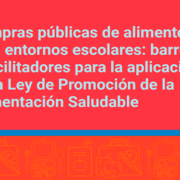Labeling Law: When and how does it start to be applied?
According to the regulations of the Law for the Promotion of Healthy Food, this August 20, large companies must begin to implement the Frontal Warning Labeling on their products. Small and Medium Enterprises (SMEs) have a deadline to do so until February 2023. The appearance of the stamps will be gradual and progressive.
“Below, we offer a google translate version of the original article in Spanish. This translation may not be accurate but serves as a general presentation of the article. For more accurate information, please switch to the Spanish version of the website. In addition, feel free to directly contact in English the person mentioned at the bottom of this article with regards to this topic”.
When did we start to see the seals?
As of this August 20, the products of large companies that have an excess of critical nutrients -such as sugars, sodium, saturated fats, total fats and calories-, must display on the main face of the container one or more warning stamps with the “EXCESS IN” badge. Also, those foods that contain sweeteners and/or caffeine, must present the precautionary legends: “CONTAINS SWEETENERS, NOT RECOMMENDED FOR CHILDREN” and/or “CONTAINS CAFFEINE, AVOID IN CHILDREN”.
In this way, the central axis of the regulation that seeks to protect and guarantee the right to information in consumer relations begins to be implemented. This is the first stage of a gradual process, in which the cut-off points are made more flexible, until reaching (in a second stage) the maximum values set by the Nutrient Profile of the Pan American Health Organization (PAHO). Tool adopted by law to classify and determine products that contain an excessive amount of critical nutrients.
In this way, the central axis of the regulation that seeks to protect and guarantee the right to information in consumer relations begins to be implemented. This is the first stage of a gradual process, in which the cut-off points are made more flexible, until reaching (in a second stage) the maximum values set by the Nutrient Profile of the Pan American Health Organization (PAHO). Tool adopted by law to classify and determine products that contain an excessive amount of critical nutrients.
According to the PAHO profile, the products that should be classified using its criteria are processed (such as fruit in syrup, cheese, or foods preserved in brine) and ultra-processed (such as sweet or salty snacks, cookies, ice cream, candies), either which are the ones that normally contain high amounts of sugars, sodium and fats. For their part, those minimally processed or unprocessed products will not bear stamps. Examples of this are fresh fruits and vegetables, dried noodles, rice, legumes or the exceptions provided by the regulations: common sugar, vegetable oils, dried fruits and common table salt.
Now, what happens to the products that we know have an excess of critical nutrients and that on August 20 are going to continue on the shelves without their corresponding seals?
These cases, which unfortunately will not be few, must be explained in one of the following ways:
1- It can be a product made by an SME, for which the first stage begins in February 2023.
2- It may be a product from a large company that has a production date prior to August 20, which according to the law may be kept on the market until stock is exhausted.
3- Or, it may be a product of a large company, with a production date after August 20, which has obtained an extension.
This last case is the one that generates the greatest concern and uncertainty in civil society. As indicated by the Provision of the National Administration of Medicines, Food and Medical Technology (ANMAT), the possibility of requesting an extension only exists for the first stage and only once. This deadline expired on July 20 for large companies.
For the purposes of said request, companies must declare and specify the products for which they make the order, as well as the specific reasons why they found limitations in meeting the established deadlines. In this framework, the ANMAT can resolve by approving or rejecting. If the extension request is approved, large companies have a maximum period to put the seals on their products, until February 2023.
Something important to note is that the regulations do not provide for the opening of this information, so in the face of secrecy, we decided to present a request for access to public information. Despite the efforts, the ANMAT replied that it could not provide us with these data as they are confidential. This decision, unfortunately, limits the possibility that civil society can be an active agent in monitoring the implementation of the law.
However, after our request, the ANMAT published a statement informing that as of July 27, 2,658 applications had already been received (encompassing a total of 236 companies), of which around 35% had been approved. However, the statement says nothing about: which companies requested an extension and why, on which products the extension was granted and the criteria for accepting or rejecting them.
This means that we will not know if those products that do not have seals, is because they obtained the extension or because they are in fact not complying with the norm. We need better transparency standards to be ensured throughout the implementation process.
What about the rest of the components of the law?
Meanwhile, it is important not to lose sight of the fact that the law not only introduces the system of “warning stamps” that will allow us to know what we eat. The seal is part of this standard that seeks to address the problem of healthy eating in a comprehensive and cross-cutting manner. Thus, the Law also contains provisions on: “Promotion, Advertising and Sponsorship”, “Education and Healthy Environments” and “Public Purchases”.
Let’s review each one and see why we say that the correct implementation of the seals is essential for full compliance with the standard:
-
School environments
According to the regulatory decree, the Ministry of Health must coordinate with the Ministry of Education and the Federal Council of Education to include in the school curriculum minimum contents of nutritional food education and guarantee that schools are healthy spaces or free of stamps. In other words, no product with at least one warning seal or precautionary legend may be offered, marketed, promoted, advertised or sponsored in educational establishments in the country.
The corresponding regulations have not been issued on this aspect. Until now, the Ministry has only advanced in the incorporation of courses on Healthy Eating in the teacher training courses.
-
Advertising, promotion and sponsorship
The labeling law prohibits the advertising, promotion and sponsorship of all those products that contain at least one (1) warning seal and that is directed especially at children and adolescents.
Likewise, it establishes that those products that contain a warning seal cannot include complementary nutritional information on their packaging, endorsement seals from scientific societies or civil associations, children’s characters, animations, celebrities, athletes, interactive elements, gifts, games, digital downloads. , etc.
According to the regulatory decree, the ANMAT has the duty to establish and dictate the complementary regulations that facilitate the implementation and control of these provisions. However, this body has not disclosed the implementation and control mechanisms that will be used to guarantee compliance with these provisions.
-
Public purchases
On this aspect, the Ministry of Health must coordinate with the National Procurement Office to guarantee that the National State, given the same convenience, prioritizes contracting those products that do not have warning stamps. This provision has significant relevance. But we still do not know how this articulation will take place, nor what will be understood by “equal convenience” or “prioritizing”.
It is important to highlight that to guarantee the full application of all aspects of the law throughout the country, the work and political will of the provinces is necessary. Either for the dictation of complementary norms that are necessary, as for the control and surveillance in their territories.
More Information
Authors
María Laura Fons
Maga Merlo Vijarra
Contact
Maga Merlo Vijarra, magamerlov@fundeps.org









